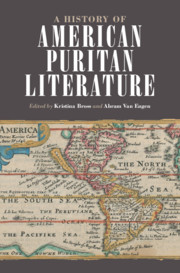Book contents
- A History of American Puritan Literature
- A History of American Puritan Literature
- Copyright page
- Dedication
- Contents
- Figures
- Contributors
- Acknowledgments
- Introduction
- Prologue
- Part I Places
- Part II Approaches
- Chapter 7 Theology
- Chapter 8 Aesthetics
- Chapter 9 Gender
- Chapter 10 Race
- Chapter 11 Print Culture
- Chapter 12 Ritual
- Chapter 13 Manuscript Culture
- Chapter 14 Environment
- Chapter 15 Science
- Chapter 16 Millennialism
- Chapter 17 Postsecularism
- Afterword
- Appendix
- Index
Chapter 12 - Ritual
from Part II - Approaches
Published online by Cambridge University Press: 24 September 2020
- A History of American Puritan Literature
- A History of American Puritan Literature
- Copyright page
- Dedication
- Contents
- Figures
- Contributors
- Acknowledgments
- Introduction
- Prologue
- Part I Places
- Part II Approaches
- Chapter 7 Theology
- Chapter 8 Aesthetics
- Chapter 9 Gender
- Chapter 10 Race
- Chapter 11 Print Culture
- Chapter 12 Ritual
- Chapter 13 Manuscript Culture
- Chapter 14 Environment
- Chapter 15 Science
- Chapter 16 Millennialism
- Chapter 17 Postsecularism
- Afterword
- Appendix
- Index
Summary
Long understood as purifying the church by rejecting worship routine and devotional ceremony, pious New England settlers in fact observed formal and informal rituals that defined lived religion within the Reformed tradition. Given that access to the vernacular word was central to puritan self-definition, literacy and reading became intensely ritualized. Thus, along with life-cycle rites (birth, marriage, death), annual and occasional ceremonies (fast days, thanksgiving days, election sermons, artillery sermons), and sabbath customs (the sacraments, the public confession, the audition of preaching), ritual was derived from the experience of books. The chapter demonstrates this experience by looking at moments of cross-cultural contact during Metacom’s War, where reading seeks to stabilize tradition. It studies reader annotations of devotional works as a means to understand the meditative, recursive, and extractive practices that grounded and routinized lay piety. And it examines the visual iconography of illustrations within devotional manuals, illustrations that idealize and demonize kinds of identity for the proper pilgrim reader. Ritual, routine, and iconography are not typically associated with puritan worship, but with an ear and eye to reading habits, we better understand experiential religion in early New England.
Keywords
- Type
- Chapter
- Information
- A History of American Puritan Literature , pp. 242 - 258Publisher: Cambridge University PressPrint publication year: 2020

